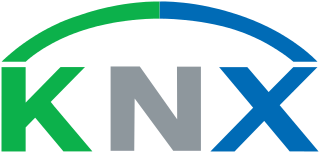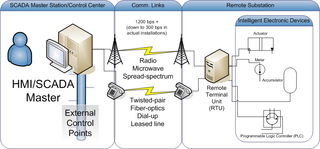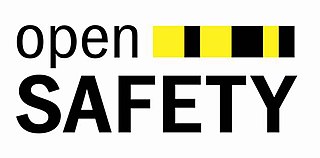Related Research Articles
SCADA is a control system architecture comprising computers, networked data communications and graphical user interfaces for high-level supervision of machines and processes. It also covers sensors and other devices, such as programmable logic controllers, which interface with process plant or machinery.

KNX is an open standard for commercial and residential building automation. KNX devices can manage lighting, blinds and shutters, HVAC, security systems, energy management, audio video, white goods, displays, remote control, etc. KNX evolved from three earlier standards; the European Home Systems Protocol (EHS), BatiBUS, and the European Installation Bus.

Profibus is a standard for fieldbus communication in automation technology and was first promoted in 1989 by BMBF and then used by Siemens. It should not be confused with the Profinet standard for Industrial Ethernet. Profibus is openly published as type 3 of IEC 61158/61784-1.

Modbus or MODBUS is a client/server data communications protocol in the application layer. It was originally designed for use with its programmable logic controllers (PLCs), but has become a de facto standard communication protocol for communication between industrial electronic devices in a wide range of buses and networks.
RS-485, also known as TIA-485(-A) or EIA-485, is a standard, originally introduced in 1983, defining the electrical characteristics of drivers and receivers for use in serial communications systems. Electrical signaling is balanced, and multipoint systems are supported. The standard is jointly published by the Telecommunications Industry Association and Electronic Industries Alliance (TIA/EIA). Digital communications networks implementing the standard can be used effectively over long distances and in electrically noisy environments. Multiple receivers may be connected to such a network in a linear, multidrop bus. These characteristics make RS-485 useful in industrial control systems and similar applications.
A fieldbus is a member of a family of industrial digital communication networks used for real-time distributed control. Fieldbus profiles are standardized by the International Electrotechnical Commission (IEC) as IEC 61784/61158.

Industrial Ethernet (IE) is the use of Ethernet in an industrial environment with protocols that provide determinism and real-time control. Protocols for industrial Ethernet include EtherCAT, EtherNet/IP, PROFINET, POWERLINK, SERCOS III, CC-Link IE, and Modbus TCP. Many industrial Ethernet protocols use a modified media access control (MAC) layer to provide low latency and determinism. Some microprocessors provide industrial Ethernet support.

Distributed Network Protocol 3 (DNP3) is a set of communications protocols used between components in process automation systems. Its main use is in utilities such as electric and water companies. Usage in other industries is not common. It was developed for communications between various types of data acquisition and control equipment. It plays a crucial role in SCADA systems, where it is used by SCADA Master Stations, Remote Terminal Units (RTUs), and Intelligent Electronic Devices (IEDs). It is primarily used for communications between a master station and RTUs or IEDs. ICCP, the Inter-Control Center Communications Protocol, is used for inter-master station communications. Competing standards include the older Modbus protocol and the newer IEC 61850 protocol.
Actuator Sensor Interface is an industrial networking solution used in PLC, DCS and PC-based automation systems. It is designed for connecting simple field I/O devices in discrete manufacturing and process applications using a single two-conductor cable.
EtherCAT is an Ethernet-based fieldbus system developed by Beckhoff Automation. The protocol is standardized in IEC 61158 and is suitable for both hard and soft real-time computing requirements in automation technology.
A protocol converter is a device used to convert standard or proprietary protocol of one device to the protocol suitable for the other device or tools to achieve the desired interoperability. Protocols are software installed on the routers, which convert the data formats, data rate and protocols of one network into the protocols of the network in which data is navigating. There are varieties of protocols used in different fields like power generation, transmission and distribution, oil and gas, automation, utilities, and remote monitoring applications. The major protocol translation messages involve conversion of data messages, events, commands, and time synchronization.
In the field of Industrial Control Systems, the interfacing of various control components must provide means to coordinate the signals and commands sent between control modules. While tight coordination is desirable for discrete inputs and outputs, it is especially important in motion controls, where directing the movement of individual axes of motion must be precisely coordinated so that the motion of the entire system follows a desired path. Types of equipment requiring such coordination include metal cutting machine tools, metal forming equipment, assembly machinery, packaging machinery, robotics, printing machinery and material handling equipment. The Sercos interface is a globally standardized open digital interface for the communication between industrial controls, motion devices (drives) and input output devices (I/O). Sercos I and II are standardized in IEC 61491 and EN 61491. Sercos III is specified in standards IEC 61800-7; IEC 61784-1, -2, -3 and IEC 61158. Sercos is designed to provide hard real-time, high performance communications between industrial motion controls and digital servo drives.
Profisafe is a standard for a communication protocol for the transmission of safety-relevant data in automation applications with functional safety. This standard was developed jointly by several automation device manufacturers in order to be able to meet the requirements of the legislator and the IFA for safe systems. The required safe function of the protocol has been tested and confirmed by TÜV Süd. The PROFIBUS Nutzerorganisation e.V. in Karlsruhe supervises the standardization for the partner companies and organizes the promotion of this common interface.

Codesys is an integrated development environment for programming controller applications according to the international industrial standard IEC 61131-3.
Sercos III is the third generation of the Sercos interface, a standardized open digital interface for the communication between industrial controls, motion devices, input/output devices (I/O), and Ethernet nodes, such as PCs. Sercos III applies the hard real-time features of the Sercos interface to Ethernet. It is based upon the Ethernet standard. Work began on Sercos III in 2003, with vendors releasing first products supporting it in 2005.
The CC-Link Open Automation Networks Family are a group of open industrial networks that enable devices from numerous manufacturers to communicate. They are used in a wide variety of industrial automation applications at the machine, cell and line levels.

openSAFETY is a communications protocol used to transmit information that is crucial for the safe operation of machinery in manufacturing lines, process plants, or similar industrial environments. Such information may be e.g. an alert signal triggered when someone or something has breached a light curtain on a factory floor. While traditional safety solutions rely on dedicated communication lines connecting machinery and control systems via special relays, openSAFETY does not need any extra cables reserved for safety-related information. It is a bus-based protocol that allows for passing on safety data over existing Industrial Ethernet connections between end devices and higher-level automation systems – connections principally established and used for regular monitoring and control purposes. Unlike other bus-based safety protocols that are suitable for use only with a single or a few specific Industrial Ethernet implementations and are incompatible with other systems, openSAFETY works with a wide range of different Industrial Ethernet variants.
The train communication network (TCN) is a hierarchical combination of two fieldbus for data transmission within trains. It consists of the Multifunction Vehicle Bus (MVB) inside each vehicle and of the Wire Train Bus (WTB) to connect the different vehicles. The TCN components have been standardized in IEC 61375.
SCADA Strangelove is an independent group of information security researchers founded in 2012, focused on security assessment of industrial control systems (ICS) and SCADA.
A smart home hub, sometimes also referred to as a "smart hub", "gateway'", "bridge", "controller" or "coordinator", is a control center/centre for a smart home, and enables the components of a smart home to communicate and respond to each other via communication through a central point. The smart home hub can consist of dedicated computer appliance, software appliance, or software running on computer hardware, and makes it possible to gather configuration, automation and monitoring of a smart house by communicating and controlling different smart devices that consist of for example home appliances, sensors and relays or robots, many of which are commonly categorized under Internet of things.
References
- ↑ "Optomux Protocol Guide". Opto22.com. 2012-01-08. Retrieved 2012-09-01.